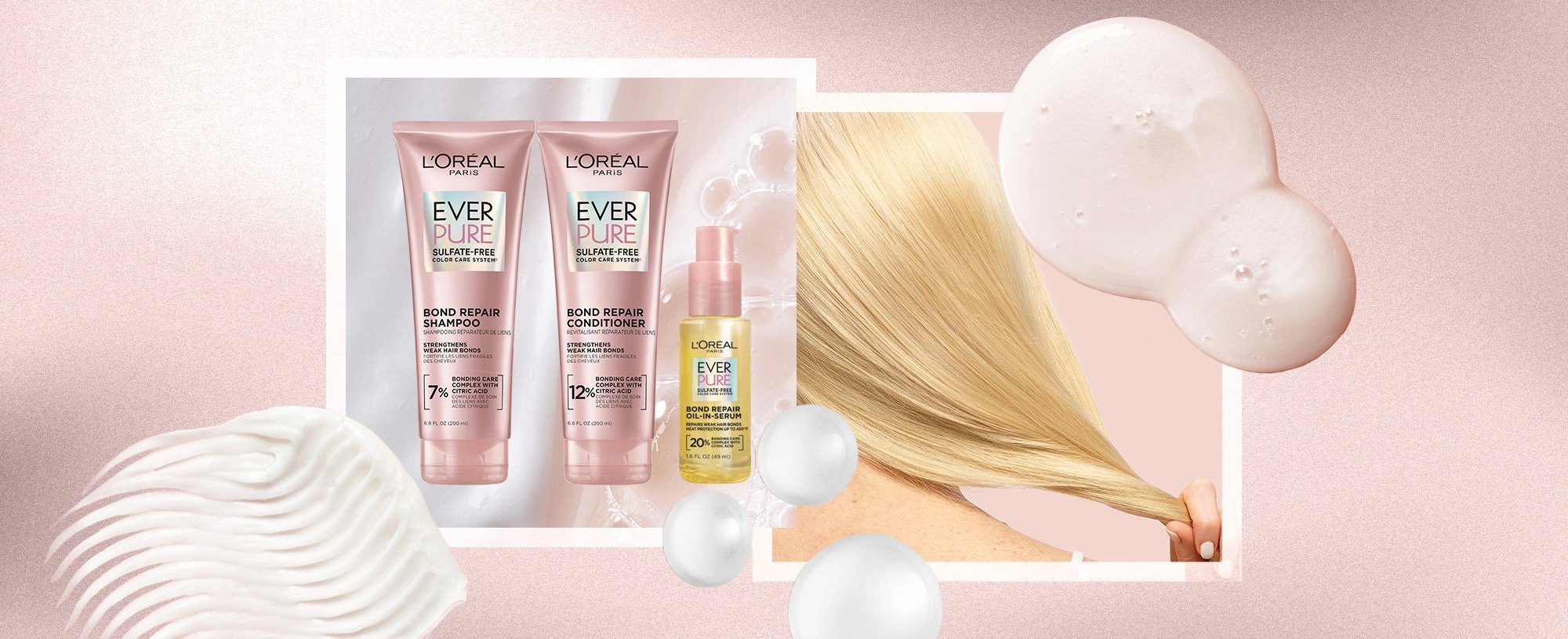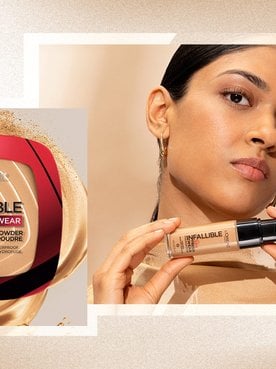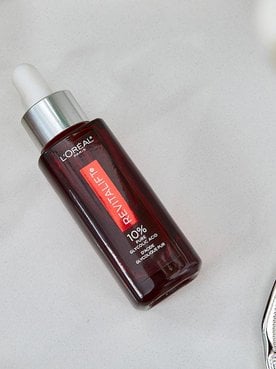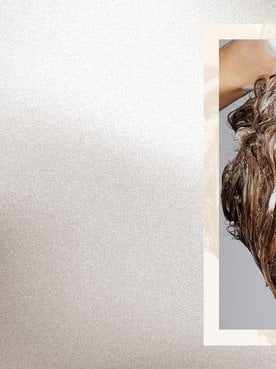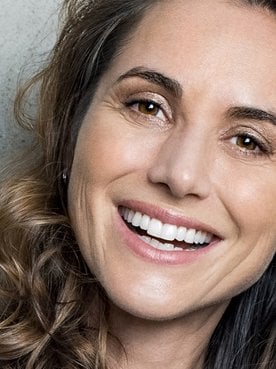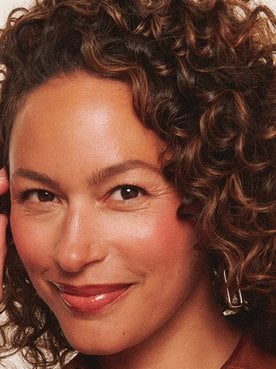There’s no denying that your hair looks amazing with a fresh color or a perfect blowout. But there’s also no denying that heat styling and coloring can damage your strands over time. You might love that pretty new platinum hue, but if you’re not taking proper care of your tresses between salon visits, your hair isn’t going to look (or feel) as healthy as it could. While some damage is unavoidable, hair bonding treatments can help strengthen your brittle, overprocessed hair. And, with bond repair hair products from the L’Oréal Paris EverPure Bond Repair collection, you can even reverse damage at home.
Here, we’ll explain what hair bonds are, how chemical and heat processing can affect them, and answer the million-dollar question, “What is hair bonding?”. Then, we’ll introduce you to the L’Oréal Paris bond repair system and teach you how to add it to your haircare routine to show your tresses the love they need.
What Are Hair Bonds?
Let’s start with a quick refresher on what hair bonds are. Hair is primarily made up of a protein called keratin (which is also the main component of nails and the top layer of your skin). This strong, fibrous protein is responsible for giving your hair its structure, and keratin molecules are linked together by chemical bonds. There are three bonds in total: hydrogen, ionic, and disulfide. Here's a quick breakdown of what each do:
- Hydrogen bonds: These temporary bonds give your hair elasticity and flexibility, allowing you to shape your strands into different styles.
- Ionic bonds: Like hydrogen bonds, ionic bonds are temporary bonds that contribute to the strength and elasticity of hair. They’re sometimes referred to as salt bonds.
- Disulfide bonds: These are strong permanent bonds that help determine the shape and structure of your strands.
How Do Hair Bonds Become Damaged?
Exposure to certain stressors can disrupt hair bonds, which in turn impacts our hair's strength, elasticity, and overall health. Some common culprits of damage include heat styling, environmental factors (sun exposure, chlorine, and saltwater), mechanical stress (rough brushing and tight hairstyles), and chemical processes (coloring, relaxing, and straightening).
Bleaching, in particular, can significantly damage disulfide bonds, according to a study published in the International Journal of Cosmetic Science. So can chemical straightening and perms, per the International Journal of Trichology. These treatments rupture your hair’s disulfide bonds, which in turn alters your hair texture. (For our curly-haired friends, this is how your hair can go from 4C curls to 3A wavy strands after a keratin treatment.) The rupturing of these bonds also explains why these types of chemical hair treatments can be extremely damaging to your hair—they literally change the makeup and structure of your tresses.

How Do You Repair Broken Hair Bonds?
The best way to repair broken hair bonds is by using a hair bonding treatment that can address damage from the inside out. Typically, damaged hair bonds manifest as dry, brittle hair with split ends and breakage. If you’re noticing these concerns (particularly after a heat or chemical treatment), you might want to consider updating your haircare routine. First, it’s a good idea to take a break from bleach, hair dye, chemical treatments, and hot tools, which can exacerbate existing damage.
Then, we highly suggest picking up a hair repair treatment. Ahead, we walk you through all you need to know about how they work and which ones to add to your cart.
What Are Hair Bonding Treatments and How Do They Work?
Hair bonding treatments are a type of haircare product designed to repair and strengthen damaged hair. These formulas often contain acidic ingredients that penetrate into the hair strand and help fortify broken or weakened hair bonds from within.
Some treatments are applied directly in the salon by a professional, while others, like the L'Oréal Paris EverPure Bond Repair System, are available for at-home use. The latter option is a trio of hair bonding products (the line includes a pre-shampoo treatment, bonding shampoo, a bond-repairing conditioner, and a leave-in oil) that smooths damaged hair in a single use so strands instantly look less damaged. Plus, the completely sulfate-free regimen gently cleanses and conditions as it works to reinforce your hair from the inside out.
All four products contain citric acid, a good-for-your-hair ingredient that can help clear excess sebum and debris on the scalp and balance your hair’s pH. Citric acid helps to neutralize the pH of haircare products, according to an article published by the Indian Journal of Dermatology. This is important because an alkaline pH of 7 or higher can cause more friction between the hair fibers, which can lead to breakage and damage to the hair cuticle, according to a study by the International Journal of Trichology.
Benefits of Hair Bonding Treatments
If you couldn’t already tell, hair bond builders can be an invaluable addition to your haircare routine. However, these powerhouse products often do more than just repair existing damage—they also work wonders in transforming the overall look and feel of your hair. Among their many benefits are:
- Enhancing shine
- Improving elasticity
- Strengthening brittle hair
- Reducing tangles
- Preventing future damage
Signs You May Need a Bond Repair Treatment
Damaged hair is hard to miss—any time your hair begins to feel or look different than usual, that’s a tell-tale sign something’s up. A few key signs that your hair may be damaged and needs a hair bonding treatment include hair breakage,dry and brittle texture, split ends, frizzy, unmanageable tresses, and even a change in your curl pattern.
As mentioned, chemical treatments—like bleaching, coloring, and perming—can damage the hair structure. Regular use of heat styling tools and excessive hair brushing can also cause noticeable damage to your mane. Be as gentle as possible when you brush or comb your hair, and if you’re going to use a heat styling tool, consider using it on the lowest heat setting. You can also spray your tresses with a heat protectant before styling to help shield your hair from the heat.

How to Use Hair Bonding Treatments in Your Haircare Routine
If you’ve been struggling to get your damaged hair back into a healthy condition, keep reading. Ahead, we’ll explain how to use the L’Oréal Paris EverPure Bond Repair system and restore your strands’ healthy appearance.
Shop the Products
1. Add a pre-poo treatment to your prep
Before you reach for your shampoo, prep your hair with a pre-shampoo concentrate. Pre-poo treatments can help address targeted concerns such as split ends, tangles, and dullness while preparing your hair for shampoo and conditioner.
Start your bond-building routine with the L’Oréal Paris EverPure Bond Strengthening Pre-Shampoo Treatment. The powerful hair bonder formula contains a 15% Bonding Repair Complex with Citric Acid and penetrates deep into the hair cortex to help rebuild weak hair bonds. We recommend applying it to damp hair and leaving it on for 5-10 minutes before shampooing and conditioning.
2. Switch to a bond repair shampoo
If your regular shampoo isn’t rebuilding your hair and protecting your color, it’s time to swap it for a hair bonding shampoo that can do both. Our recommendation is the L’Oréal Paris EverPure Sulfate-Free Bond Repair Shampoo with Citric Acid. This shampoo gently cleanses while helping to strengthen all types of weak, brittle hair. In other words, it’s exactly what you need to bring your dull, overprocessed strands back to life.
Apply to wet hair and gently massage the product into a thick lather. Rinse thoroughly with warm water, and then proceed to your conditioner as usual.
3. Condition the right way
After shampooing, you’ll want to follow up with a hair bonding conditioner, which can reinforce the hair and protect it against damage caused by color, heat, and bleaching. We recommend the L’Oréal Paris EverPure Sulfate-Free Bond Repair Conditioner with Citric Acid. Like the other products in this collection, it helps rebuild weak hair bonds—and when used alongside the pre-shampoo and shampoo, leaves hair smoother, stronger, and easier to detangle.
Apply it to wet hair an inch down from the roots, massage gently into the hair from the lengths to the tips, and rinse. If you need to brush up on your conditioner skills, check out our article, 8 Conditioner Mistakes To Avoid.
4. Style with confidence

Once you’ve finished your in-shower bonding regimen, move on to styling as usual. The L’Oréal Paris EverPure Bond Repair Hair Oil-In-Serum is a bonding hair treatment that features everything you need to prep your hair for styling: It protects against heat damage, makes hair shiny and soft, and reinforces weakened bonds, leaving locks up to seven times stronger. What we love most, though, about this formula is its versatility: You can use it on damp hair as a styling primer or on dry hair as a finishing touch.
When used as a complete four-step system, L’Oréal Paris EverPure Bond Repair helps protect your tresses from future damage so that you can color and style your hair without worry.
Maintenance Tips After Using Hair Bonding Treatments
Congrats! You’re one step closer to healthier-looking hair. To keep your mane looking and feeling its best, consider implementing these maintenance tips into your routine:
1. Limit heat styling and chemical services
When trying to maintain healthy-looking hair after a hair bonding treatment, it’s a good idea to limit your use of hot tools. Applying high heat directly to your strands can contribute to damage, which is not ideal when trying to strengthen weakened hair bonds. The same goes for chemical treatments such as bleaching, coloring, and perming—you’ll want to save these services for when your hair is in better condition. If you must pick up the flat iron or blow dryer, turn them to a lower setting—the goal is to use a temperature that can effectively style your hair without requiring multiple passes.
2. Get regular trims
Besides using a good bond treatment for hair, regular trims are another way to help prevent split ends from traveling up the hair shaft and causing brittleness and breakage. As we’ve said before, it’s generally recommended that you get a haircut every six to eight weeks. However, this is not a one-size-fits-all rule and depends on your hair’s condition and how quickly it grows.
3. Protect your hair from the environment
Prolonged exposure to UV radiation can cause a decrease in fatty acid on the hair cuticle, which may manifest as brittle hair and loss of shine or color fade. And air pollutants such as polycyclic aromatic hydrocarbons (PAHs) can penetrate hair fibers, causing chemical damage to the cuticle and structural proteins, according to the New York Society of Cosmetic Chemists.
To protect the hair and scalp from these environmental factors, use detoxing haircare products regularly and cover your strands with a hat or scarf whenever possible.
Next Up: How Often Should You Wash Damaged Hair?
Photo courtesy of L’Oréal Paris
